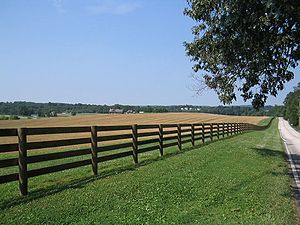The Number of Posts and Rails calculator computes the number posts and rails needed for a wood fence (e.g. post and rail / split-rail) based on the length of the rails, the number of rows and the total length of the fence.
INSTRUCTIONS: Choose units and enter the following:
- (L) Total Length of Fencing
- (PS) Post Separation.
- (nR) Number of rows of rail
Number of Posts and Rails (P&R): The calculator returns the number of posts and rails.
The Math / Science
The Number of Rails equation computes the number of rails needed for a fence based on the perimeter (p) of the fencing, the uniform length (l) between the posts and the number of rails between the posts.
Note: the standard lengths of Post and Rail fences are typically eight feet (8') and eleven feet (11'). Furthermore, the standard post and rail fence posts come with two or three holes for rails.  Eight sided fence enclosure
Eight sided fence enclosure
Note: standard post and rail fences are typically eight feet (8') or eleven feet (11') long.
To estimate the Material Cost for a Post and Rail Fence, estimate the number of fence posts to match the length of fence. Then estimate the number of fence rails to match the length of fence and the number of the rails. It then use the total number of posts and rails and the unit prices to compute the total cost of a post and rail fence.
Split Rail Pricing Information
The Post and Rail (split-rail) Pricing table contains recent fence prices for a variety of fence components with prices from Lowes, Home Depot, Menards and potentially other stores based on their web sites. The prices are in U.S. dollars.
The most recent split-rail fence price survey information is:
- Date of Split-Rail Price Survey: 5/8/25
- Store (online) Surveyed: Menards
- Price of a standard 11 foot fence rail: $16.48 USD
- Price of a two hole post: $17.69 USD
- Price of a three hole post: $24.99 USD
- Price of a two hole corner post: $17.69 USD
- Price of a three hole corner post: $24.99 USD
CAUTION: The pricing information provided is for calculating convenience with NO implied guarantees to the accuracy of the values listed. Authoritative sources should be sought to confirm any value before risking health or wealth on the veracity of the data. Furthermore, Calc gives no guarantee that you will be able to buy products at listed prices or even if they will be available. The data provided is purely a convenience for making estimates, so we repeat, ALWAYS use local pricing and authoritative specifications.
Fence Calculators
 Number of Posts and Rails: Computes the number of fence posts and rails needed for a length of wood fencing.
Number of Posts and Rails: Computes the number of fence posts and rails needed for a length of wood fencing.- Post and Rail Fence Cost Estimate : Computes material costs for post and rail fence based on the number of posts and rails (above) and unit cost pricing.
- Wire Fence Materials: Computes the materials needed for a high tension fence.
- Wire Fence Cost Estimate Computes the materials and costs of a high tension wire fence.
- Labor Cost for Posts : Computes the approximate cost of labor in digging and setting fence posts based on the length of the fence, uniform distance between posts, method of digging (by hand, power auger) and the hourly labor pay rate (DPH).
- Perimeter of a Rectangular Shaped Area computes the length of a fence perimeter in a rectangular shaped area base on the length (l) and width (w) of the area.
- Diagonal of Rectangle Area computes the diagonal measurement of a rectangular area. This is useful in ensuring that your area has square corners.
- Three Sided Land Fencing: Computes the number of fencing segments or posts needed to go around a three sided fence area.
- Circular Fence Calc computes the diameter, number of posts, rails, perimeter and area of a circular shaped fenced area (paddock).
- Fencing Needed for Polygon Area: Computes the area and side length enclosed within a polygon (e.g. octagon) shaped area (paddock).
- Area Fenced in Polygon: Computes the area enclosed in polygon (e.g., 12 sided) fence area based on the length and number of individual sides.
- Fencing Needed for Circular Area
computes the number of posts, number of sections, sides or panels, number of rail boards, perimeter and area of a ROUGHLY CIRCULAR shaped area (paddock) based on a diameter and length of sides.
- Number of Posts needed for a Wood Fence: Computes the number of posts needed for a length of fence based on the spacing.
- Number of Rails needed for a Wood Fence: Computes the number of rails needed for a length of fence based on the length of the rails and number of rows.
- Garden Fence: Computes the number of T-posts and length of fencing needed based on the garden dimensions, separation of the T Posts and the length of the fencing in the flexible rolls.
